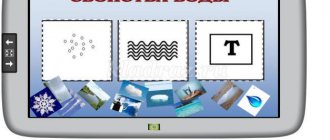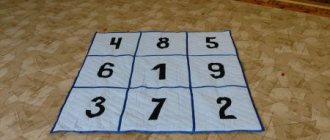Card index “Didactic games with children of senior preschool age according to traffic rules”
Natalia Rotova
Card index “Didactic games with children of senior preschool age according to traffic rules”
Didactic games on traffic rules for preschoolers.
Purpose of the games
: Fix the names of transport and pedestrian traffic lights, their location and purpose. For the games, you need to prepare the following materials: multi-colored lids (green, red and yellow) with a hole in the center of the lid, laces, and paper templates of pedestrian traffic lights.
Didactic game “Assemble a traffic light”
.
To play, children must be divided into teams. Each participant is given a cord. At the presenter’s signal, for a time (take an hourglass for 1 or 2 minutes), participants need to string as many caps of the appropriate color as possible to create a traffic light.
Task options: string caps of the appropriate color to create a pedestrian traffic light;
String the covers so that the traffic lights alternate - first for transport, then for pedestrians, etc.
Didactic game “Guess the transport”.
Objectives: to consolidate children’s ideas about transport, the ability to recognize objects by description (riddle); develop ingenuity, quick thinking and speech activity. Rules: You can name a vehicle only after the riddle about it is told. The one who gives the most correct answers wins, that is, the one who received the most pictures with transport.
Progress of the game. Children sit in a semicircle. Educator. Children, we talked about transport, watched it move along the road, and today we will play a game called “Guess the Transport”. Listen to the rules of the game. I will ask riddles about transport, and you must think and guess them correctly. Whoever guesses first what kind of transport is being discussed in the riddle receives a picture with its image. Whoever has the most pictures at the end of the game will win. The house is a wonderful runner on its eight legs. Runs in an alley along two steel snakes. (Tram) What a miracle this bright house is? There are a lot of passengers in it. Wears rubber shoes and eats gasoline. (Bus) Guess what it is: Neither a bus nor a tram. Doesn't need gasoline, although the wheels are on rubber. (Trolleybus) You can see them everywhere, you can see them from the windows, They move along the street in a fast stream. They transport various cargoes - bricks and iron, grain and watermelons. (Trucks) This horse doesn't eat oats, Instead of legs there are two wheels. Sit on horseback and ride it! Just drive better! (Bicycle) I’ll swing my long neck, I’ll pick up a heavy load. Wherever they order, I will put it, I serve Man. (Crane) A “mole” has climbed into our yard and is digging at the gate. He replaces hundreds of hands, He digs without a shovel. (Excavator) It rushes like a fiery arrow, a car rushes into the distance. And any brave squad will douse the fire. (Fire truck) *** A canvas, not a path, A horse is not a horse - a centipede. He crawls along that path, carrying the whole convoy alone. (Train) *** They don’t feed you oats, they don’t drive you with a whip, And when you plow, you drag 5 plows. (Tractor) *** For him to take you, He won’t ask for oats. Feed him gasoline, give him rubber for his hooves. And then, raising dust, He will run. (Automobile)
Didactic game "Jolly Rod".
Objectives: generalize ideas about the rules of behavior for pedestrians on the street; activate children's knowledge, their speech, memory, thinking; cultivate a desire to comply with traffic rules in life.
Rules: listen carefully to the answers of your comrades and do not repeat yourself. The team that names the most rules for pedestrians wins. You can give an answer only after receiving the rod.
Progress of the game. The teacher divides the children into two competing teams and tells them the name of the game and its rules. Educator. The one to whom I give the baton will have to name one of the rules of behavior for a pedestrian on the street. These rules cannot be repeated, so be very careful! The team that names the most rules and does not repeat itself will win. The rod passes alternately from one team to another. Children name the rules. Children. You can cross the street using a pedestrian underpass or only when the traffic light is green. Pedestrians are only allowed to walk on sidewalks; If there is no sidewalk, you can move along the left shoulder towards the traffic. It is forbidden for small children to cross the street in front of nearby traffic and for small children to cross the street without an adult. Before crossing the street, you need to look first to the left, then to the right and, making sure it is safe, cross.
Didactic game “Find such a sign”
. The teacher and the children make road signs out of cardboard (thick paper). 3-4 children participate in the game. They are given signs (equally to each). The teacher has a set of signs. He shows one of the signs and invites the children to find the same one. What a sign this is!
Option 1 The game is played with a subgroup of children. The teacher selects road signs familiar to the children. Showing a sign, for example, “Pedestrian crossing,” asks: What does this sign mean? Where is it placed? This sign is placed at the pedestrian crossing. It means that only in this place is it allowed to cross the street.
Option 2 The teacher attaches all the road signs familiar to the children to the flannelgraph and asks: I want to cross the street, what road sign should I find to determine the crossing location? Children show a sign. We went on vacation out of town and wanted to eat. What sign can help us find the dining room? The children answer. Our car broke down. By what sign can we determine where the car can be repaired? Etc.
Didactic game “You can - you can’t, right - wrong.”
Goals: To form in children ideas and a responsible attitude towards what is and is not possible on the street, road and in transport.
Materials for the game: Cards with correct and incorrect behavior of children (situations) on the road, on the street and in transport (bus and subway.) Cards with a smiling sun and a sad sun for each player.
Progress of the game:
I option. All children take part in the game. The teacher gives the children cards with a smiling sun and a sad sun. Consistently shows cards with various situations of children’s behavior on the street, road, and in transport. Children raise the card with the sun that corresponds to the given situation, i.e. you can behave this way in transport or on the street (smiling sun) or not (sad sun), whether the children act correctly or not. The one who not only raises correctly wins corresponding card, but will also explain why he picked it up.
Option II. No more than six children take part in the game. The teacher distributes cards with situations to the children, 4 cards to each child. Children lay them out in front of them. Cards with suns are placed in the middle of the table. Children look at their cards, take the sun and put it on the card with the situation corresponding to the expression (happy or sad sun). The winner is the one who is the first to cover all situations with cards with suns and tell why he covered this picture with a happy or sad sun.
Didactic game “Road signs for pedestrians”
.
Objectives: To consolidate knowledge and purpose of road signs.
Materials for the game: Signs “Pedestrian crossing”, “Pedestrian traffic is prohibited”, “Underground pedestrian crossing”, “Overground pedestrian crossing”, “First aid station”, “Slippery road”, “Bicycle path”, “Bicycle traffic is prohibited” ", "Road works", "Railway crossing without a barrier", "Dangerous turn", "Rough road". 4-5 signs per child.
Progress of the game. The whole group or several children take part in the game. The teacher gives the children 4-5 road signs. Children lay them out in front of them. The teacher reads out the rule for pedestrian behavior on the road, and the child shows the corresponding road sign and explains its purpose and importance for the pedestrian. The winner is the one who correctly shows all the road signs and talks about the purpose of this or that road sign for a pedestrian.
Didactic Lotto game “Learn to be a pedestrian.”
Goals: Continue to introduce children to the rules of safe behavior on the street. Strengthen knowledge of road signs necessary for pedestrians. Materials for the game: Large cards, with various situations on the roads (according to the rules of behavior of children on the road, on the street and in transport). There are six situations on each card. Small cards with road signs and traffic rules on the back and white cards crossed out diagonally.
Progress of the game. No more than six children take part in the game. The teacher distributes large cards to the children (one card to one child). Shows a card with a road sign and reads the rules of conduct on the road or in transport. The child looks at the card, finds the appropriate situation and puts a small card with a road sign or a white card on it (if the situation indicates the child’s incorrect behavior on the road or in transport). The first one to cover all six situations on his card wins. Didactic games for developing thinking and attention
Didactic game "Traffic Light".
Objectives: To give children an idea of the purpose of a traffic light and its signals. Continue to reinforce children’s ideas about color (red, yellow, green). Materials for the game: Colored cardboard mugs (red, yellow, green); traffic light layout.
Progress of the game. The teacher hands out yellow, red, green mugs to the children. The traffic light switches sequentially, and the children show the corresponding circles and explain what each signal means. The winner is the one who correctly shows all the circles and talks about the purpose of the colors.
Didactic game "Red and Green".
Goal: To teach children to establish connections between objects and phenomena, to act on a signal.
Materials for the game: Two mugs (green and red, a typewriter.
Progress of the game: The game is played with one child. The teacher takes two mugs - red and green - invites the child to take a toy: a car and says: - You, Vasya, the driver, will drive the car yourself. When I show the green circle, the car can drive. Like this (shows). When you see the red circle, the car should stop. The teacher plays with the child. On the green circle the child moves the car on the table, on the red circle he stops. In subsequent lessons, the game is played with a subgroup of children. Used during didactic games to show illustrations of transport, streets, houses. 16. Didactic game “Colored cars”. Children are placed along the wall of the room or along the edge of the playground. They are cars. Each player is given a flag of any color (optional) or a colored circle or ring. The teacher stands facing the players in the center of the room (playground). He holds three colored flags in his hand. The teacher raises a flag of some color. All children with a flag of this color run around the playground (in any direction, they honk as they go, imitating a car. When the teacher lowers the flag, the children stop and each go to their garage. Then the teacher raises a flag of a different color, and the game resumes. Teacher can raise one, two or all three flags together, and then all the cars leave their garages. If the children do not see that the flag is down, the teacher supplements the visual signal with a verbal one: “The cars (names the color) have stopped.” The teacher can replace the color signal with a verbal one (for example: “Blue cars are leaving”, “Blue cars are coming home”).
Didactic game "Horses".
The children become pairs: one is the horse, the other is the driver. To play, reins are given or children hold on to a belt. Let's go, let's go, With nuts, with nuts, a turnip for grandpa. For the boy, For the sweetie. Little by little. With the end of the text, the children continue to run in the same rhythm, accompanied by the teacher’s sentence of “gop, gop.” or click their tongue until the teacher says: “Whoa.” When repeating the game, children change roles. After everyone is comfortable with the game, the teacher suggests raising their knees while running. You should start the game with one pair, gradually increasing the number of participants to 3-4 pairs.
Didactic game “Running traffic light”. Children follow the leader. From time to time the presenter raises the flag, then turns around. If the green flag is raised, the children continue to move behind the leader; if the flag is yellow, they jump in place; if the flag is red, everyone must “freeze in place” and not move for 15-20 seconds. Whoever makes a mistake leaves the game. The most attentive one wins.
Didactic game "Traffic Light".
Two teams of 5 to 7 people line up in a semicircle, one to the left, the other to the right of the teacher. In the hands of the teacher there is a traffic light - two cardboard circles, one side of which is yellow, the other side of the circles is different (red or green). The teacher reminds the children how important it is to follow the traffic rules on the street, cross it only in designated places where the sign “crossing” is written, first look to the left to make sure that there is no car nearby, and where there is a traffic light, carefully monitor it . The teacher reads poems by S. Mikhalkov to the children. The guys suggest the missing words in unison. If the light turns red, then move... (dangerous). The green light says: “Come on, the way is (open).” Yellow light - warning - Wait for the signal to....(move). Then the teacher explains the rules of the game: - When I show a green traffic light, everyone marches in place (you need to start with the left foot, when it’s yellow, they clap their hands, and when it’s red, they stand still. The one who mixed up the signal takes a step back. Signals should change unexpectedly, at different intervals.The team that has the most participants left at the end of the game wins.
Didactic game “We are young motorists.”
The teacher, having checked the children’s knowledge of traffic rules, hands each of them a driver’s license. Having received a driver's license, children of senior and preparatory groups move around the playground, observing the rules of the road: Stick to right-hand traffic.
• Respond correctly to traffic lights.
• Let pedestrians pass (children of the younger group with a teacher).
Didactic game "Burners".
The players become pairs. A line is drawn in front of the column at a distance of 2-3 steps. One of the players - the catcher - stands on this line. Everyone standing in the column says: Burn, burn, clear. So that it doesn't go out. Look at the sky - Birds are flying, Bells are ringing! One, two, three: run! After the word “run,” the children standing in the last pair run along the column (one on the right, the other on the left, trying to meet, and join hands. The catcher tries to catch one of the pair before the children have time to join hands. If the catcher manages to do this, then he forms a new pair with the caught one and stands in front of the column, and the one left without a pair becomes the catcher. If the catcher fails to catch anyone, he remains in the same role. The game ends when all the players run once. The game can be repeated 2— 3 times.The number of participants should not exceed 15-17 people, otherwise the children will have to stand motionless for a long time.
Didactic game "Stop".
At a distance of 10-16 steps from the border of the site, a line is drawn (the original one, on which the players stand close to each other. At the opposite end of the site, the driver’s place is outlined in a circle (2-3 steps in diameter). Turning his back to the players, the driver says loudly: “Quickly walk, look, don't yawn! Stop!" At these words, all the players move towards the driver. As soon as the driver says the word "Stop!", everyone stops, the driver quickly looks around. The one who did not have time to stop in time after the word "Stop!" and made an additional movement, the driver returns to the starting line. Then he again turns his back to the players and says: “Walk quickly.”, etc. Everyone continues moving from the place where they were caught by the “stop!” signal. Those who returned to the starting line, start moving from there. This continues until one of the players comes close to the driver and stands in a circle before the driver says “stop!”. The one who managed to do this becomes the driver . The game resumes with a new driver.
Didactic game “Skillful Pedestrian”.
Option 1. At a distance of 60 cm, 5 m of cord are placed parallel to each other. You have to walk blindfolded along the path between them. Option 2. Two circles are made from two cords - outer and inner. The distance between them is 1 m. You need to walk in a circle between the cords blindfolded.
Didactic game “Stop - Go”.
Preparing for the game: Children players are located on one side of the room, and the driver with a pedestrian traffic light in his hands is located on the other.
Rules of the game: Players, at the traffic light signal “Go”, begin to move towards the driver. At the “Stop” signal they freeze. At the signal “Go” I continue moving. The one who reaches the driver first wins and takes his place. Players can move by running or in small rooms by “liliputians”, moving their feet to the length of the foot, heel to toe.
Game "Our Friend the Guard".
Look: the guard stood on our pavement, quickly extended his hand, deftly waved his wand. Have you seen it? Have you seen it? All the cars stopped immediately. They stood together in three rows and didn’t go anywhere. The people are not worried, they are walking across the street. And stands on the pavement, Like a guard guard. All machines obey one. (Ya. Pishumov) Preparing for the game: Explain why and when a traffic controller is needed. Consider in the pictures the designations of the traffic controller’s gestures (which gesture corresponds to which traffic light signal). Rules of the game: Leader-guard. Children players are divided into pedestrians and drivers. At the traffic controller's gesture, drivers and pedestrians walk (drive) or stop. Initially, the teacher takes on the role of guard. Then, when children have mastered the traffic controller's gestures, they can take turns performing this role. 29. Game "Find a safe path." Preparing for the game: Depending on the age of the children, the teacher tells or asks the children: Is it possible to cross the street everywhere? • What signs indicate that it is legal to cross the street in this area?
• Where and why should you look at the beginning of a street crossing?
• Where and why should you look in the middle of a street along which cars are driving in both directions? What does a pedestrian crossing sign look like and what does it warn about?
• Why was a zebra drawn on the road?
Game "Where is my place?"
.
Preparation for the game: Designing a road, placing warnings on the road (school, cafeteria, road repairs, etc., corresponding to the traffic signs studied.
Rules of the game: The players' task is to replace verbal warnings with the necessary signs.
The game can be played in two versions. 1. One player places the signs, the rest evaluate the correctness. 2. Two players compete to see who can place the signs faster and more correctly.
Game "Confusion". Preparing for the game: The teacher constructs a road in advance and places the signs incorrectly (near the Zebra there is a “Slippery Road” sign, etc.) Then he tells the children a story about how evil spirits decided to create chaos in the city, asking for help to correct the situation. Rules of the game: Children, having turned into good wizards, place the signs correctly. They explain what they are doing.
Game "Road Test"
.
Preparing for the game: Construction of the road and placement of signs.
Rules of the game: Child-driver-student passing the test for the right to drive a car. He “drives” along the road and, seeing this or that sign, explains what he must do. For example: there is a slippery road ahead. I slow down and drive carefully, not overtaking other cars.
Game "Fulfill the assignment."
Preparing for the game: Construction of the road and placement of the studied signs.
Rules of the game: Children from the “dispatcher” (educator) are given the task to go, for example, to the hospital. The child goes and comes back. Then he receives two tasks at once: “Go to the railway crossing, then eat.” The child must complete the tasks in the given sequence. Gradually, the number of simultaneous orders increases.
Game "Turns".
Preparing for the game: Children line up facing the teacher. If the game is played by a subgroup of 6 people, then the children are given steering wheels. The teacher has signs: “Move straight”, “Move right”, “Move left”.
Rules of the game: If the teacher shows the sign “Move straight,” then the children take one step forward; if the sign is “Move right,” the children imitate turning the steering wheel and turn right; if the sign “Move left,” the children imitate turning the steering wheel and turn left. .
Game "How to get there?"
Preparing for the game: Designing a road using the signs “Move straight”, “Move right”, “Move left”. Points of departure and destination are marked.
Rules of the game: Children (one to three) must drive correctly to their destination. The winner is the one who did it faster without violating traffic rules.
Game "Guess the sign".
Preparing for the game: All studied signs are placed at a distance from each other.
Rules of the game: The teacher reads out a verbal description of what this or that sign means. Children must run to the right sign. Children who choose the sign correctly receive a token. At the end of the game, they count how many tokens they have and determine the winners.
Progress of the game:
Read a poem to the children about a road sign; whoever guesses it gets the sign. The child who collects the most characters wins.
"Road Lotto"
Goal: To consolidate children's knowledge of traffic rules; learn to find the right road signs depending on the situation on the road; develop logical thinking, memory, attention, observation.
Material: Cards with situations on the road, road signs.




